Did you know that some plants are big time troublemakers in the garden (invasive, prolific spreaders, aggressive) but they are amazing STARS in patio pots and container gardens?
My blog page titled “Troublemakers Turned Stars” talks about which troublemaker garden plants you may use in container gardens. And, it starts with this plant:
Petasites japonicus (butterbur)
Its key feature: HUGE ruffled green leaves reaching 32″ wide. It prefers shade and may be used in water gardening because it likes moisture – lots of it. In fact, in a container garden, you need to provide it with a nice long watering to soak the soil well daily in the heat of hot summers.
Why it’s a star in container gardens and patio pots: Because of its huge leaves. I like lush foliage, so this one is a keeper. And because you can overwinter it very easily in a big container garden or patio pot just by moving it into a sheltered location after the season is over towards the end of Autumn.
My storage location for this plant growing in large patio pots is my little shed or unheated garage. I’ve been moving pots with Petasites in it for 3+ years now at the end of the season to store them over the winter. It is best to cut back all the foliage after it gets hit by a light frost in Autumn.
In the Spring, roll it back out, position it somewhere to show the big leaves off which follow its flowering cycle. This plant is interesting. It shoots out flower buds first and leaves start coming out in various places in the pot after.
Here is a photo below taken this month of the flower pods rising. Once you have this pot outdoors, be sure to cut off the flower heads before they start to set seed because you do not want it to be carried by wind to your landscape to take hold because in the ground, this baby spreads like wildfire and is hard to control. You don’t want it in places where it will take over the landscape unless you know how to control it very carefully. And one way to control a plant like this is to use it in container gardens and patio pots.
Why it’s a troublemaker: This plant has rhizomes at the base, and they grow rapidly via a spreading habit. In the garden, they would easily take over an area and invade. They can be a problem to remove. In fact, in a container garden, sometimes the roots will creep up to the top of the pot or out of the bottom of the pot’s drainage holes. They are ambitious. One way to provide extra reinforcement is to sit the pot on top of another as shown here.
Caution: If you decide to use this plant in a container garden, be aware when it flowers, the seeds can self-sow in the garden. Sometimes, I’ve kept mine raised above the ground on an elevated deck, so this has not been an issue. Or again, as shown above, situate it on top of another pot filled with soil so if the roots escape, they will go into the soil in the pot below it.
At the end of the season, rolling these back into a sheltered location such as a garage, shed, or other space is plenty of protection to keep it alive in a dormant state until the climate and conditions are favorable for reappearance each spring.
This is why I love using perennials which return every year in pots – they save you money – and become treasured specimens. In many cases, troublemaker perennial plants are great candidates for container gardening.
To see more about Petasites japonicus, click HERE. It is a blog posting I wrote a couple years back with more photos of the plant’s flowers, root structure, and habit.
The leaves on this plant grow to dish plate size which make them very showy. When you put them away at the end of the season, it is helpful to moisten the soil so there is a bit of moisture, and visit it maybe once during the winter to put some snow on top to melt into the soil – this is what has worked for me.
Here’s a variegated Petasites I scored last year from The Garden Barn and Nursery in Vernon, CT. I’m glad to see the variegation on the leaves returning right now in my blue pot. After a few years, this pot may require a refresh of new potting soil – and a division of the plants.
Perennials like this are wonderful candidates in container gardens, and reasons why perennials will be discussed at this year’s Container Garden Workshops on May 16th and May 23rd, 2015. To learn more about the workshops in Broad Brook, CT, see HERE.
Detailed information about the plant and characteristics can be located HERE at the Missouri Botanical Garden website.
Stay tune for more about “Troublemakers Turned Star” plants for container gardens and patio pots.
Cathy Testa


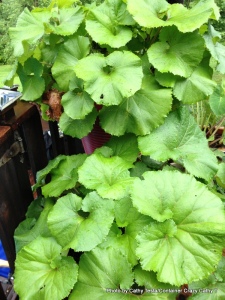
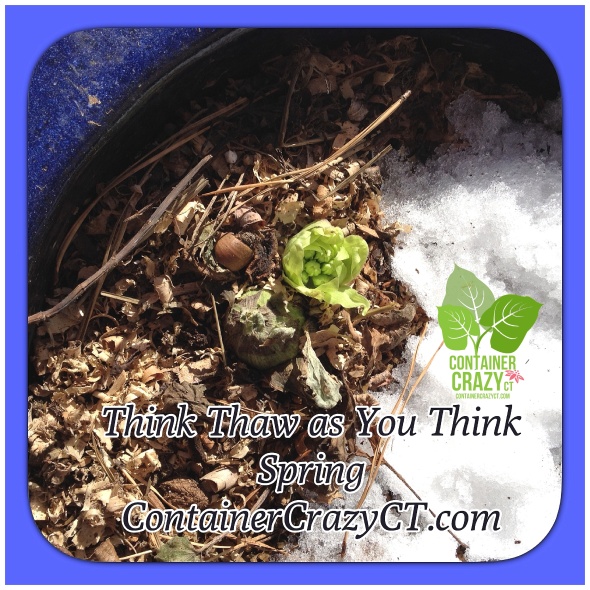
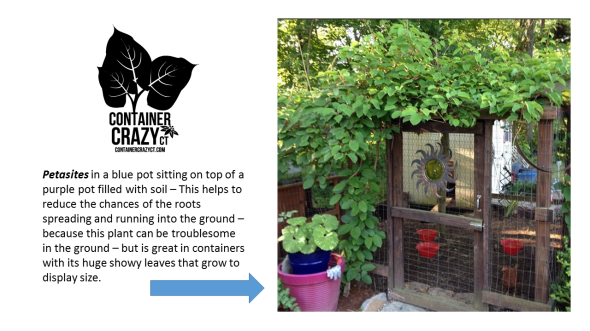

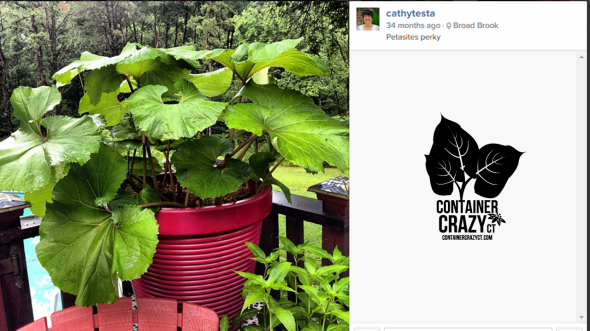
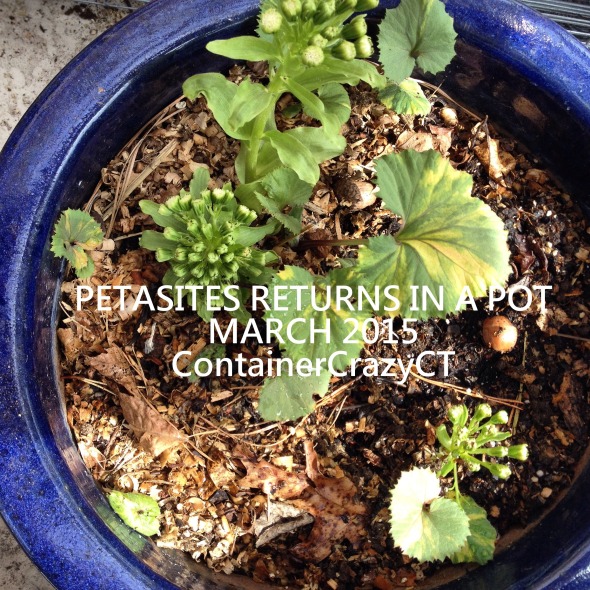

Down here in NC, it’s Creeping Jenny. the only place I will use it anymore is in a pot…and I am very careful to keep it from touching the ground.
Interesting about creeping Jenny. I saw it once in a bed at a person’s home and it was sprawling but I’ve never grown it myself in the ground, only in containers as a nice spiller plants.
Great name, beautiful foliage, but sounds like it should always come with a warning label.
I always thought about that – Imagine if plants had tags with warning labels – OMG, I don’t think the nursery bz would like that too much cause it could scare people away, but also, people are super concerned about our environment so if something is invasive or a spreader, a new icon should perhaps appear. I also read how a big chain store is starting to add icons for plants sprayed with particular pesticides. They want to inform their buyers. Thanks for reading my post!
Love the beautiful foliage!
I agree Bonnie – Foliage is fantastic, and I love huge leaves which bob in the wind and they also shade plants below them in container gardens.
And it’s one of those great edible weeds!
Thanks for the reminder on that! I had forgotten about the edible parts!
Pingback: Search Terms – A Look at Last Week’s | Container Crazy Cathy T
If I trim off petasites japonicas leaves that insects (or slugs) got to during the season (May-September), will new leaves grow or am I stuck with no leaves on that plant?
Usually, from what I recall growing this in containers, yes, new leaves always regrow in the growing season. I think that should be fine! Cathy
Trimming off leaves is fine, it should push new growth in the spring.
Hi, I thought I had replied but if you did not see that earlier, yes, I believe new leaves would grow early in season but not later perhaps. Cathy T.
A question: When I overwinter most plants in the garage, I don’t water them but once in the middle of winter. Since this is a boggy/moisture-lover, I wonder if I need to water it/keep it moist over the winter?
Most things that I overwinter in the garage I only water maybe once in mid winter. Since this is a bog/moisture loving plant, should I be keeping it wetter over the winter?
No, when I put mine in the shed, in my backyard, I never watered it. It probably would not hurt to do some just a bit to keep the soil on the moist side from time to time, but I had success with just ignoring it. The shed is out in my backyard and in shade however, no sun to dry it out.